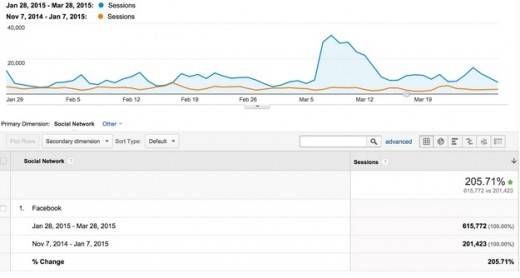
Andrianes Pinantoan heads growth marketing at Canva, an online design tool that helps you and your team create stunning visual marketing assets faster and easier than ever.
Have you noticed it? Recently, more and more companies have started complaining about the declining amount of traffic Facebook drives to their website.
Some have gone so far as to delete their page altogether, declaring that Facebook is dead as a free customer acquisition channel.
The mindset: “An email marketing campaign gets upward of a 50 percent open rate while less than 5 percent of my fans see my Facebook updates – why would I bother?”
Now don’t get me wrong, email marketing is great, but avoiding Facebook is definitely a mistake.
Firstly, Facebook is the single biggest driver of traffic among all social media platforms. Not by a little, but by a big margin. And secondly, we recently discovered a simple way to grow our Facebook traffic by 200 percent.
To restore your faith in how Facebook can be an awesome driver of traffic for your brand, I’m going to show you how we did it.
How Canva Grew Facebook Traffic By 205.71%
First off, a screenshot of our Facebook traffic:
The orange line is our traffic between November and January (pre strategy), and the blue line between January and March – after. One post went viral during this period – accruing more than 70,000 shares, most of them of course, on Facebook. But that’s not the interesting part.
The interesting part is how we consistently found a way to generate more traffic from Facebook over 60 days across more than 20 posts.
This is an important distinction because we have a tendency to over-analyse why a single post goes viral – when in fact it can be attributed to simple luck. To really know if something is working, it has to be repeatable.
The other important point to note is that we didn’t pay Facebook to promote our posts. And we didn’t start optimising the time we posted on our Facebook page, nor the frequency of our posts, nor any of the usual advice Facebook “experts” tell you to do.
Here’s what we did: optimise our blog. I’ll go into exactly how we optimised it, but first, let me just point out a few tell-tale clues as to why this is important.
This has been true for a while now, but Facebook has gone further with its latest update: it’s prioritising your friend’s content in news feed over pages. Optimising your content’s reach through your Facebook page is therefore like having the best equipped soldiers fighting an uphill battle. Sure you might win a couple of times, but it’s unlikely.
A better way to do get traffic from Facebook is to get your readers to share your content with their friends instead. The math adds up too.
Let’s say you have 10,000 fans on your page, and let’s further assume Facebook is a magnanimous dictator who allows you to reach all your fans. The median number of friends people have on Facebook is about 200 friends, so in this scenario, you really only need 50 people to share your content to reach the same amount of audience.
In reality, only about five percent of your fans will see your page’s update, which in this case amounts to just 500 people. You need three people to share your stuff to reach the same amount of audience. Three!
Share rate – the percentage of your readers who share your content – varies from website to website, but it’s something you can improve through relentless testing. Your Facebook page reach? You can’t do anything about it.
So we stopped trying to, and we shifted our focus from “social media” to content. And that’s when our Facebook traffic really skyrocketed.
Want to know how we did it? I’m going to break down the steps we took to boost and show you how you can too.
-
Learn from the best in your industry
The first thing we did is to learn from the best – our industry competitors. There’s a reason why all wheels are round. Previously, we would try to come up with original ideas and write about topics that promote “thought leadership”. We wrote what interested us.
Sometimes the article we published would catch on. But many other times they didn’t.
To remove the guesswork, we looked to our competitors and analysed which content was already popular on their site using an awesome tool called Buzzsumo. To show you how this works, I’ve searched The Next Web’s URL. Here’s the top three pieces of content:
If The Next Web was your competitor, you would monitor the trends you see here. Firstly, announcements and tech news are a hit. This would provide an incentive to release news first. Secondly, list posts which are traditionally more popular don’t seem to work here. This is a valuable lesson – just because everyone else is doing it, doesn’t mean you need to.
Another great technique is to go to Pinterest and search for your industry keywords. Which articles get the most pins? And Topsy. Which article gets the most tweets?
Now here’s the key. Don’t just copy competitors’ content. That’s unoriginal, and I’m sure (like us) you have a lot of value to add to the web. So – improve on it.
To do this we asked ourselves questions such as:
- Is this article outdated? Would our readers be interested in an updated version?
- Can this article be improved with specific examples?
- Can this article benefits from more visuals?
- Is this article missing key pieces of information? Is it comprehensive enough?
- Does it lack actionable items?
- Can we add our own unique experience to make this article better?
So now, before we even wrote a single word, we knew there would be an audience for our content before we even wrote it.
-
Get to really know your readers
Of course, studying your competitors is just one source of inspiration. The other great source of inspiration is to simply ask your readers.
We frequently conduct surveys to find out what our users are struggling with most in their business. But by far the best source of information regarding what our users want to read is in our “welcome email” when you subscribe to our blog updates.
Here’s a screenshot of the email:
We get dozens of replies to this email every day. We get people who write a three sentence reply, and we get people who write an essay about their struggles.
We compile their ideas so we answer their problems with our content. But more importantly, the emails tells us who we are writing for. Are they small business owners or corporate marketers? Are they stay-at-home mums or startups?
It gives us a genuine connection with the people we’re trying to reach. In the case of Canva, we noticed a lot of businesses struggle with design, yet very few blogs in our research focused on writing about design for small businesses.
Sure, there’s are a lot of really great content about web and mobile UX/UI and topics like that, but what if you’re a cafe owner who needs to design your own marketing materials? Or an indie book author who needs to design your own book cover?
That’s where we found our unique value add.
-
Keep up to date with trending topics
Now that you know what your incumbent competitors are doing, and you know what your readers want, it’s time to set your targets.
In our case, for example, we’ve identified a market gap for small business owners who need design tips. But there are hundreds of topics within the design industry – everything from mobile UX to interior design –which ones should we prioritise?
This is where trends come into play. All things being equal, your blog has a better chance of succeeding if it’s about a hot topic that is naturally getting more popular.
Everything to do with mobile, for example, is growing in popularity these days. That’s why you see blogs dedicated exclusively to everything about mobile tech.
Infomercials, however, have been in decline for decades so you almost never see a blog about infomercials anymore. You can write the best content and implement the best tactics there are, but the odds of a blog about infomercials taking off is simply against you.
The best way to do this is to keep up with what influencers in your industry are saying on Twitter. Or, follow hashtags. Both will give you an indication of what large groups of people are following.
-
Test your headline – there’s no such thing as a copywriting “expert”
It was only after we nailed our strategy that we went into specific tactics. The first one is the most obvious: headlines. Think you’re copywriting expert? Think again.
There’s simply no way to know which headline will work better unless you test. Here, for example, is one example from Canva:
Exact same article, posted on the exact same page – one received 24 likes and 3 shares, while the other received 43 likes and 21 shares. Now multiply that improvement across all of our users sharing that post directly from our blog and you can see how much of a difference a simple change in the title can make.
So why did one title perform better than the other? You can theorise all day. But know this: the original losing variation? That’s modeled based on a post that previously went viral (the one that received 70,000 shares).
We thought we could repeat that success without testing. We were wrong. So how can you test your headlines? It’s pretty simple.
We simply share the post with its original title, wait a few days, and change the title and share it again. We are working on integrating a plugin that will help us do a proper A/B test, but if you can’t afford it, do what we are doing.
-
Write epic content – people read more online than you think
People don’t read online, right? We stuck to short blog posts because we vehemently believed that. We wanted to go straight to the point and just tell our readers what to do. Of course it turned out to be a myth.
Even without all the studies showing why longer content gets more shares and links, our own competitor research showed that those who lead the market write epic content. So we started following their lead.
And we’ve never looked back since. One of our most popular posts, as it turns out, is more than 5,000 words long. But epic is more than just long. Epic means your post must:
- Fulfill a need. Do your readers actually want to read about this?
- Be Unique. And not as in “pass a checker” unique. Unique here means people-can’t-find-this-information-anywhere-on-the-web unique. What can you add to the web with this post? If we are curating design resources, for example, we don’t do a Google search and see what appears on other people’s lists. We dig through Behance and find the latest cool stuff.
- Contain multi-media. A single image is a must. The study I linked to above found posts with at least one image get more shares than plain text. Our own, informal, testing found the more images you use in a post, the more shares you tend to get. Especially on Pinterest. See what happens when you search for Design School on Pinterest. There’s a flood of images – not posted by us, but by readers from within our posts.
- Be specific. Tell people exactly what to do. Give them step-by-step instructions. With screenshots if possible. Don’t say, “You need analytics!” Tell them what tool to use, what to track and how to analyse the data. With instructions of exactly which buttons to click. Using case studies and examples are a great way to be specific.
- Be comprehensive. It should cover everything a beginner needs to know about a particular topic, not just bits and pieces of information. Comprehensive articles are not always long and long articles are not always comprehensive – this is an important distinction.
-
Go the extra mile
So you wrote epic content. All done, right? Well, not quite. Remember, the higher the standard of your content is, the more difficult it will be for your competitors to enter your market. To really set yourself apart, go the extra mile and DO the hard work for your readers.
Take this example from Design School where we wrote about what makes an effective design brief. What do you think readers of that post want after reading that post?
A template, that’s what! They want an actionable way to put the lesson into practice.
And that’s exactly what we did. We created a design brief for them to download at the end of the post – so not surprisingly, many of the tweets we get mentioned the free template.
Summary
Now you might say all these tips I just shared with you don’t apply to just Facebook. They are tips for great content marketing.
And you’d be right.
But here’s the lesson you can’t ignore: elevated traffic from Facebook is a symptom of great content marketing.
The way I see it – you have three options.
- Do nothing different, and wonder why your traffic isn’t growing. (More people choose this option than you think)
- Spend [x] amount of dollars on Facebook advertising and get [x] amount of likes.
- Build a community, grow your customer loyalty, give value to the people who believe in your brand and double your traffic.
We know which one we would choose.
Read Next: The 29 rules of social media – and which ones to break
Get the TNW newsletter
Get the most important tech news in your inbox each week.








